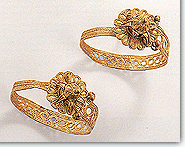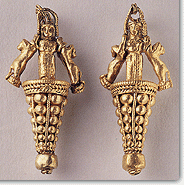





     | |
|
Jewellery making greatly flourished during the Archaic period. The developed mining activity of the period and the expansion of commercial transactions throughout the colonies provided the necessary precious metals. Relations with the East gave fresh impetus to techniques and its rich iconography stimulated the imagination of Hellenic craftsmen. The most important sources of gold that were controlled by the Greeks in the Archaic years were the rivers Pactolus in Asia Minor and Echedorous (Gallikos) in Macedonia, the Pagaeon mountain, Thasos and Siphnos. Also gold was imported to Greece from the ores in Egypt, in Nubia, in Lydia and in Caucasus. In most of the aforementioned regions there was also mining of silver, whereas the |
 | The basic techniques were forging, repousse technique in stone, wooden and bronze moulds, engraving, the use of stamps for repeated motifs, casting with the process of "cire perdue", casting in moulds, filingree technique and the technique of granulation. The two last techniques required high skills and were known in Phoenicia and Etruria. Granulation reached a high level of uniformity and alignment of the granules, during the |
 | A series of impressive necklaces consisting of plaques with representations of Potnia Theron 'Mistress of the Animals' have been attributed to Rhodes. Pendants of similar detailed work come from Sindos in Macedonia with fusiform and vase-shaped beads and periapts worked in the filigree and granulation, which are dated in the second half of the |
|
| |
|
Note: Click on picture for short description. | |